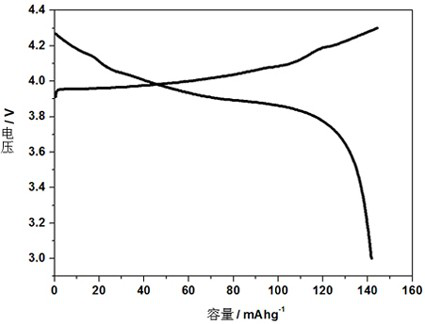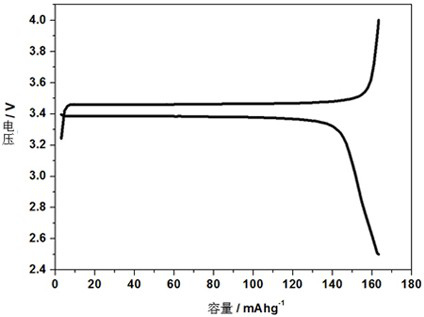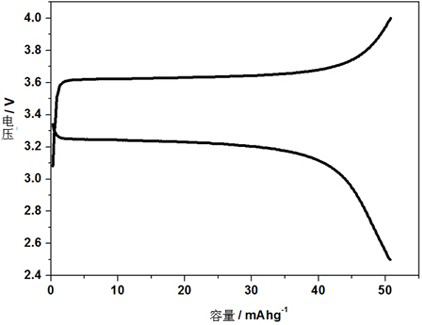High-safety solid-state electrolyte, preparation method and application thereof
A solid electrolyte, safe technology, applied in the direction of solid electrolyte, non-aqueous electrolyte, non-aqueous electrolyte battery, etc., can solve problems such as battery damage
- Summary
- Abstract
- Description
- Claims
- Application Information
AI Technical Summary
Problems solved by technology
Method used
Image
Examples
Embodiment 1
[0104] Under anhydrous and oxygen-free conditions, 2,3-dihydroxypropyl acrylate, 1,6-hexamethylene diisocyanate and lithium difluorooxalate borate were formulated into a homogeneous solution at a mass ratio of 2:8:2. This solution was then assembled into LiCoO 2 / Li battery, and placed the battery in an incubator at 80°C for 10 hours of polymerization. The thermal decomposition temperature of the electrolyte is as high as 350 °C, and there is no melting point, the assembled LiCoO 2 / Li button battery has a discharge specific capacity of 140mAh / g at 60°C, a discharge specific capacity of 120mAh / g at room temperature, and a discharge specific capacity of 150mAh / g at 120°C. The discharge specific capacity at a high temperature of 150°C drops to 40 mAh / g, and the ionic conductivity of the polymer electrolyte decreases by an order of magnitude compared to that at 100°C.
Embodiment 2
[0106] Under anhydrous and oxygen-free conditions, 2,3-dihydroxypropyl methacrylate, isophorone diisocyanate and lithium bistrifluoromethanesulfonimide were formulated into a homogeneous solution at a mass ratio of 2:8:5 . This solution was then assembled into LiFePO 4 / Li battery, and placed the battery in a thermostat at 60°C for 12 hours to polymerize. The thermal decomposition temperature of the electrolyte is as high as 350 °C, and there is no melting point, the assembled LiFePO 4 / Li button battery has a discharge specific capacity of 150mAh / g at 60°C, a discharge specific capacity of 130mAh / g at room temperature, and a discharge specific capacity of 160mAh / g at 120°C. The discharge specific capacity at a high temperature of 150°C drops to 50 mAh / g, and the ionic conductivity of the polymer electrolyte drops significantly compared to that at 100°C.
Embodiment 3
[0108] Under anhydrous and oxygen-free conditions, hydroxyethyl methacrylate, isophorone diisocyanate, and lithium bistrifluoromethanesulfonimide were formulated into a homogeneous solution at a mass ratio of 2:8:2. This solution was then assembled into LiFePO 4 / Li battery, and placed the battery in a thermostat at 60°C for 10 hours to polymerize. The thermal decomposition temperature of the electrolyte is as high as 350 °C, and there is no melting point, the assembled LiFePO 4 / Li button battery has a discharge specific capacity of 140mAh / g at 60°C, a discharge specific capacity of 120mAh / g at room temperature, and a discharge specific capacity of 150mAh / g at 120°C. The discharge specific capacity at a high temperature of 150°C drops to 50 mAh / g, and the ionic conductivity of the polymer electrolyte drops significantly compared to that at 100°C.
PUM
| Property | Measurement | Unit |
|---|---|---|
| Thermal decomposition temperature | aaaaa | aaaaa |
| Discharge specific capacity | aaaaa | aaaaa |
| Discharge specific capacity | aaaaa | aaaaa |
Abstract
Description
Claims
Application Information
 Login to View More
Login to View More - R&D
- Intellectual Property
- Life Sciences
- Materials
- Tech Scout
- Unparalleled Data Quality
- Higher Quality Content
- 60% Fewer Hallucinations
Browse by: Latest US Patents, China's latest patents, Technical Efficacy Thesaurus, Application Domain, Technology Topic, Popular Technical Reports.
© 2025 PatSnap. All rights reserved.Legal|Privacy policy|Modern Slavery Act Transparency Statement|Sitemap|About US| Contact US: help@patsnap.com



